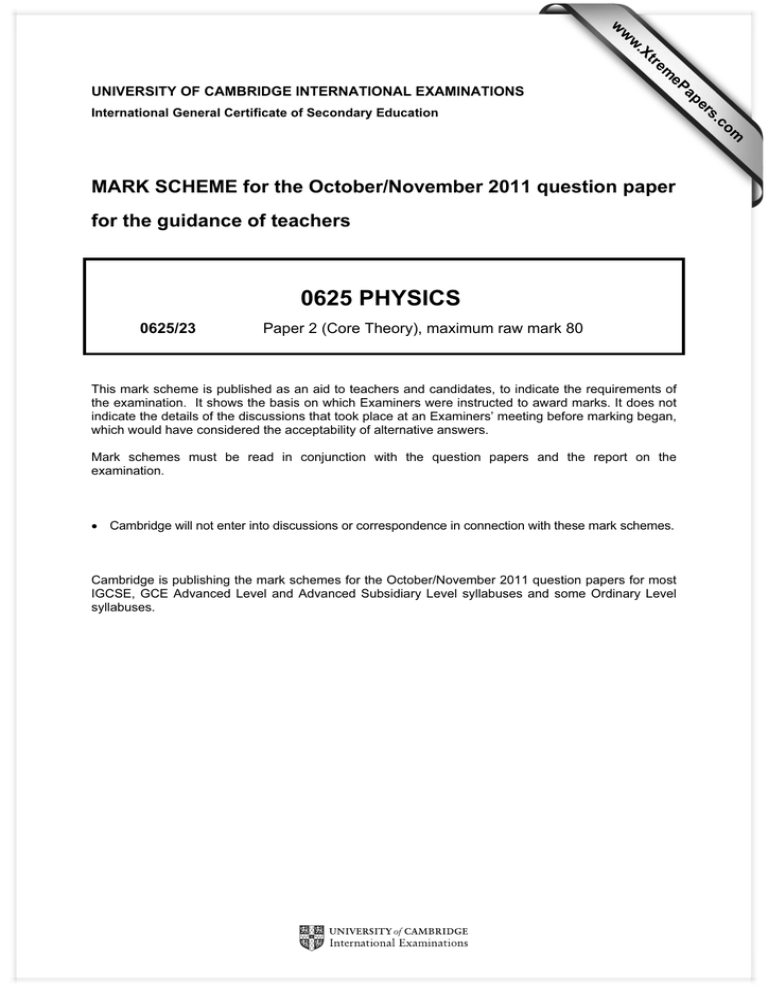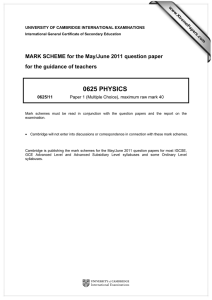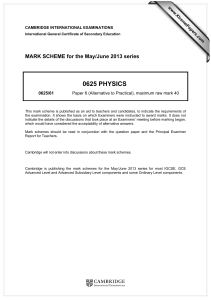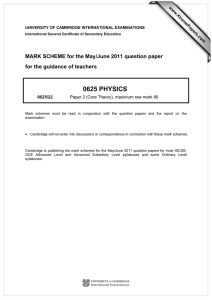0625 PHYSICS MARK SCHEME for the October/November 2011 question paper
advertisement

w w ap eP m e tr .X w UNIVERSITY OF CAMBRIDGE INTERNATIONAL EXAMINATIONS for the guidance of teachers 0625 PHYSICS 0625/23 Paper 2 (Core Theory), maximum raw mark 80 This mark scheme is published as an aid to teachers and candidates, to indicate the requirements of the examination. It shows the basis on which Examiners were instructed to award marks. It does not indicate the details of the discussions that took place at an Examiners’ meeting before marking began, which would have considered the acceptability of alternative answers. Mark schemes must be read in conjunction with the question papers and the report on the examination. • Cambridge will not enter into discussions or correspondence in connection with these mark schemes. Cambridge is publishing the mark schemes for the October/November 2011 question papers for most IGCSE, GCE Advanced Level and Advanced Subsidiary Level syllabuses and some Ordinary Level syllabuses. om .c MARK SCHEME for the October/November 2011 question paper s er International General Certificate of Secondary Education Page 2 Mark Scheme: Teachers’ version IGCSE – October/November 2011 Syllabus 0625 Paper 23 NOTES ABOUT MARK SCHEME SYMBOLS & OTHER MATTERS B marks are independent marks, which do not depend on any other marks. For a B mark to be scored, the point to which it refers must actually be seen in the candidate's answer. M marks are method marks upon which accuracy marks (A marks) later depend. For an M mark to be scored, the point to which it refers must be seen in a candidate's answer. If a candidate fails to score a particular M mark, then none of the dependent A marks can be scored. C marks are compensatory method marks which can be scored even if the points to which they refer are not written down by the candidate, provided subsequent working gives evidence that they must have known it. e.g. if an equation carries a C mark and the candidate does not write down the actual equation but does correct working which shows he knew the equation, then the C mark is scored. A marks are accuracy or answer marks which either depend on an M mark, or which are one of the ways which allow a C mark to be scored. c.a.o. means "correct answer only". e.c.f. means "error carried forward". This indicates that if a candidate has made an earlier mistake and has carried his incorrect value forward to subsequent stages of working, he may be given marks indicated by e.c.f. provided his subsequent working is correct, bearing in mind his earlier mistake. This prevents a candidate being penalised more than once for a particular mistake, but only applies to marks annotated "e.c.f." e.e.o.o. means "each error or omission". brackets ( ) around words or units in the mark scheme are intended to indicate wording used to clarify the mark scheme, but the marks do not depend on seeing the words or units in brackets. e.g. 10 (J) means that the mark is scored for 10, regardless of the unit given. underlining indicates that this must be seen in the answer offered, or something very similar. OR/or indicates alternative answers, any one of which is satisfactory for scoring the marks. Spelling Be generous about spelling and use of English. If an answer can be understood to mean what we want, give credit. Significant Answers are acceptable to any number of significant figures ≥ 2, except if figures specified otherwise, or if only 1 sig. fig. is appropriate. Units Incorrect units are not penalised, except where specified. More commonly, marks are allocated for specific units. Fractions These are only acceptable where specified. Extras Ignore extras in answers if they are irrelevant; if they contradict an otherwise correct response or are forbidden by mark scheme, use right + wrong = 0 Ignore Indicates that something which is not correct is disregarded and does not cause a right plus wrong penalty. © University of Cambridge International Examinations 2011 Page 3 Not/NOT Mark Scheme: Teachers’ version IGCSE – October/November 2011 Syllabus 0625 Paper 23 Indicates that an incorrect answer is not to be disregarded, but cancels another otherwise correct alternative offered by the candidate i.e. right plus wrong penalty applies. © University of Cambridge International Examinations 2011 Page 4 1 2 3 Mark Scheme: Teachers’ version IGCSE – October/November 2011 Syllabus 0625 (a) 25km B1 (b) (i) accelerating OR increasing speed B1 (ii) steady/constant speed B1 (iii) decelerating OR retarding OR slowing down B1 (c) less than B1 (a) Brownian (motion) B1 (b) bombardment by (water) molecules/particles/atoms random OR from all directions M1 A1 (a) strain/elastic/potential B1 (b) Y OR vertical OR straight down B1 (c) (i) 1. M1 A1 M1 A1 2. number of oscillations/vibrations/swings per second/unit time NOT in a certain time displacement/distance from mean position maximum (note: XY or YZ score M1A1) (ii) decreases or equivalent 4 B1 (a) (i) liquid B1 (ii) gas/vapour B1 (iii) liquid B1 (b) condensation B1 given to the jug/surroundings OR changes to another form (a) 30.98 – 30.72 0.26 (g) B1 C1 A1 © University of Cambridge International Examinations 2011 [5] [3] B1 (d) Y OR vertical OR straight down (c) decreases OR 5 Paper 23 [8] [5] Page 5 6 7 Mark Scheme: Teachers’ version IGCSE – October/November 2011 Syllabus 0625 (b) D = M/V in any form candidate's 0.26/200 0.0013 e.c.f. from (a) g/cm3 C1 C1 A1 B1 (a) (i) reflection OR wave bounces back from large object/sea bed M1 A1 (ii) speed = distance/time in any form 1500 × 0.8 1200 (m) C1 C1 A1 (iii) 600 (m) OR ½ × candidate’s (ii), correctly evaluated B1 (b) line with positive gradient straight line OR meets horizontal axis to right of graph origin M1 A1 (a) (i) image behind mirror image same distance from mirror, by eye and image-object line perpendicular to mirror, by eye M1 (ii) (ignore any arrows) reflected ray reaching eye direction of reflected ray coming from image 8 Paper 23 [6] [8] A1 B1 B1 (b) HIS B1 (c) both rays straight on at first surface 30° prism ray refracted down in air at 2nd surface 45° prism ray reflected down in glass at 2nd surface 90° reflection, by eye straight on at 3rd surface B1 B1 M1 A1 A1 [10] (a) (i) limit/control current OR adjust resistance B1 (ii) ammeter shows a reading B1 (iii) copper and iron ticked –1 e.e.o.o. B1 (b) (i) voltmeter NOT voltameter (ii) voltmeter shown in parallel to heater (condone incorrect symbol if clear it is a voltmeter) NO e.c.f. from (i) (c) (i) top heater and switch correctly connected middle 2 heaters and switch correctly connected © University of Cambridge International Examinations 2011 B1 B1 B1 B1 Page 6 Mark Scheme: Teachers’ version IGCSE – October/November 2011 Syllabus 0625 (ii) R = V/I in any form 250/2.5 100 ohm OR Ω C1 C1 A1 B1 (iii) smaller ticked 9 Paper 23 B1 [12] (a) (i) iron OR ferromagnetic unmagnetised (before being brought near magnet) NOT non-magnetic (ii) magnet B1 B1 B1 (b) attracts (at first) NOT goes towards repels after touching OR angle of thread increases as XY decreases B1 B1 10 (a) (i) deflection (in one direction) idea of momentary OR goes back to zero again M1 A1 (ii) idea of same as (i) but opposite direction B1 (b) larger B1 (c) smaller B1 (d) nothing OR small oscillations about zero position OR blurred light spot B1 11 (a) (i) background contaminated surfaces (any sort) other radioactive material nearby radiation from rocks/soil cosmic rays/radiation from space radon gas from ground any 1 (ii) 136/4 34 (counts/min) (b) (i) alpha OR α (ii) 876 – (a figure between 131 and 136, inclusive) division by 4 185 – 186 (counts/min) 12 (a) (i) 3 C1 A1 B1 C1 C1 A1 B1 © University of Cambridge International Examinations 2011 [6] B1 B1 (ii) 3 e.c.f. (i) [5] [7] Page 7 (b) Mark Scheme: Teachers’ version IGCSE – October/November 2011 Syllabus 0625 Paper 23 (iii) 4 B1 (iv) 7 OR candidate’s (i) + (iii), correctly evaluated B1 7 and 3 e.c.f. from (ii) and (iv) © University of Cambridge International Examinations 2011 B1 [5]





